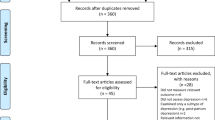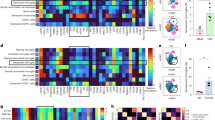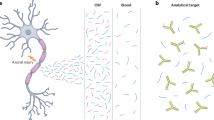Key Points
-
Knowledge of changes in dementia occurrence can only be acquired through population-based studies conducted at different time periods in representative samples derived from the same populations
-
Such studies must use diagnostic and research methods that are as similar as feasible across time to enable valid comparisons
-
We synthesize worldwide evidence from 14 such population-based studies across Western Europe, the USA, Japan and Nigeria; most have reported declining or stable prevalence and incidence with varying sex differences across countries
-
No single risk or protective factor has explained these changes, but societal changes in western societies have improved cognitive reserve and health status across the lifecourse
-
Integrating analytical epidemiological approaches and neuroscience within population-based studies is key to understanding the changes observed, underlying neurobiological mechanisms, and what policies might sustain such improvements
Abstract
Dementia is an increasing focus for policymakers, civil organizations and multidisciplinary researchers. The most recent descriptive epidemiological research into dementia is enabling investigation into how the prevalence and incidence are changing over time. To establish clear trends, such comparisons need to be founded on population-based studies that use similar diagnostic and research methods consistently over time. This narrative Review synthesizes the findings from 14 studies that investigated trends in dementia prevalence (nine studies) and incidence (five studies) from Sweden, Spain, the UK, the Netherlands, France, the USA, Japan and Nigeria. Besides the Japanese study, these studies indicate stable or declining prevalence and incidence of dementia, and some provide evidence of sex-specific changes. No single risk or protective factor has been identified that fully explains the observed trends, but major societal changes and improvements in living conditions, education and healthcare might have favourably influenced physical, mental and cognitive health throughout an individual's life course, and could be responsible for a reduced risk of dementia in later life. Analytical epidemiological approaches combined with translational neuroscientific research could provide a unique opportunity to explore the neuropathology that underlies changing occurrence of dementia in the general population.
This is a preview of subscription content, access via your institution
Access options
Access Nature and 54 other Nature Portfolio journals
Get Nature+, our best-value online-access subscription
$29.99 / 30 days
cancel any time
Subscribe to this journal
Receive 12 print issues and online access
$209.00 per year
only $17.42 per issue
Buy this article
- Purchase on Springer Link
- Instant access to full article PDF
Prices may be subject to local taxes which are calculated during checkout



Similar content being viewed by others
Change history
17 May 2017
In the version of this article initially published online, the affiliations for Karine Pérès, Chengxuan Qiu and Britt-Marie Sjölund were incorrect. These errors have been corrected in the print, HTML and PDF versions of the article.
References
Prince, M. et al. World Alzheimer Report 2015. The global impact of dementia: an analysis of prevalence, incidence, cost and trends. Alzheimer's Disease International https://www.alz.co.uk/research/WorldAlzheimerReport2015.pdf (2015).
Department of Health. G8 dementia summit declaration. GOV.UK https://www.gov.uk/government/publications/g8-dementia-summit-agreements/g8-dementia-summit-declaration (2013).
World Health Organization. First WHO ministerial conference on global action against dementia. World Health Organization http://www.who.int/mental_health/neurology/dementia/ministerial_conference_2015_report/en/ (2015).
Brayne, C. & Davis, D. Making Alzheimer's and dementia research fit for populations. Lancet 380, 1441–1443 (2012).
Wu, Y.-T. et al. Dementia in Western Europe: epidemiological evidence and implications for policy making. Lancet Neurol. 15, 116–124 (2016).
Brayne, C., Stephan, B. C. M. & Matthews, F. E. European perspective on population studies of dementia. Alzheimers Dement. 7, 3–9 (2011).
Hofman, A. et al. The prevalence of dementia in Europe: a collaborative study of 1980–1990 findings. Int. J. Epidemiol. 20, 736–748 (1991).
Fratiglioni, L. et al. Incidence of dementia and major subtypes in Europe: a collaborative study of population-based cohorts. Neurologic Diseases in the Elderly Research Group. Neurology 54, S10–S15 (2000).
EU Joint Programme – Neurodegenerative Disease Research. 21st century EURODEM. Redefining dementia for epidemiology. JPND research http://www.neurodegenerationresearch.eu/wp-content/uploads/2015/02/21st-Century-EURODEM.pdf (2014).
Bell, J. F. et al. Existing data sets to support studies of dementia or significant cognitive impairment and comorbid chronic conditions. Alzheimers Dement. 11, 622–638 (2015).
Alzheimer Association. 2015 Alzheimer's disease facts and figures. Alzheimers Dement. 11, 332–384 (2015).
World Health Organisation & Alzheimer's Disease International. Dementia: a public health priority. World Health Organization http://www.who.int/mental_health/publications/dementia_report_2012/en/ (2012).
Sachdev, P. S. Is the incidence of dementia declining? A report for Alzheimer's Australia. Alzheimer's Australia https://www.fightdementia.org.au/sites/default/files/Paper_39_Is_the_incidence_of_dementia_declining.pdf (2014).
Prince, M. et al. Recent global trends in the prevalence and incidence of dementia, and survival with dementia. Alzheimers Res. Ther. 8, 23 (2016).
Roehr, S., Pabst, A., Luck, T. & Riedel-Heller, S.G. Secular trends in the incidence of dementia in high-income countries: a protocol of a systematic review and a planned meta-analysis. BMJ Open 7, e013630 (2017).
Erkinjuntti, T., Østbye, T., Steenhuis, R. & Hachinski, V. The effect of different diagnostic criteria on the prevalence of dementia. N. Engl. J. Med. 337, 1667–1674 (1997).
Grimmer, T. et al. Trends of patient referral to a memory clinic and towards earlier diagnosis from 1985–2009. Int. Psychogeriatr. 27, 1939–1944 (2015).
Kukull, W. A. et al. Interrater reliability of Alzheimer's disease diagnosis. Neurology 40, 257–260 (1990).
Pérès, K. et al. Trends in the prevalence of dementia in French farmers from two epidemiological cohorts. J. Am. Geriatr. Soc. 65, 415–420 (2017).
Hebert, L. et al. Change in risk of Alzheimer disease over time. Neurology 75, 786–789 (2010).
Rocca, W. A. et al. Trends in the incidence and prevalence of Alzheimer's disease, dementia, and cognitive impairment in the United States. Alzheimers Dement. 7, 80–93 (2011).
Manton, K., Gu, X. & Ukraintseva, S. Declining prevalence of dementia in the U.S. elderly population. Adv. Gerontol. 16, 30–37 (2005).
Langa, K. M. et al. Trends in the prevalence and mortality of cognitive impairment in the United States: is there evidence of a compression of cognitive morbidity? Alzheimers Dement. 4, 134–144 (2008).
Wiberg, P., Waern, M., Billstedt, E., Östling, S. & Skoog, I. Secular trends in the prevalence of dementia and depression in Swedish septuagenarians 1976–2006. Psychol. Med. 43, 2627–2634 (2013).
Wimo, A. et al. Cohort effects in the prevalence and survival of people with dementia in a rural area in Northern Sweden. J. Alzheimers Dis. 50, 387–396 (2016).
Qiu, C., von Strauss, E., Bäckman, L., Winblad, B. & Fratiglioni, L. Twenty-year changes in dementia occurrence suggest decreasing incidence in central Stockholm, Sweden. Neurology 80, 1888–1894 (2013).
Lobo, A. et al. Prevalence of dementia in a southern European population in two different time periods: the ZARADEMP Project. Acta Psychiatr. Scand. 116, 299–307 (2007).
Matthews, F. E. et al. A two-decade comparison of prevalence of dementia in individuals aged 65 years and older from three geographical areas of England: results of the Cognitive Function and Ageing Study I and II. Lancet 382, 1405–1412 (2013).
Hall, K. S. et al. Prevalence rates for dementia and Alzheimer's disease in African Americans: 1992 versus 200. Alzheimers Dement. 5, 227–233 (2009).
Langa, K. et al. A comparison of the prevalence of dementia in the United States in 2000 and 2012. JAMA Intern. Med. 177, 51–58 (2017).
Sekita, A. et al. Trends in prevalence of Alzheimer's disease and vascular dementia in a Japanese community: the Hisayama Study. Acta Psychiatr. Scand. 122, 319–325 (2010).
American Psychiatric Association. Diagnostic and Statistical Manual of Mental Disorders 3rd edn revised (American Psychiatric Association, 1987).
Folstein, M., Folstein, S. & McHugh, P. R. A practical method for grading the cognitive state of patients for the clinician. J. Psychiatr. Res. 12, 189–198 (1975).
Lawton, M. P. & Brody, E. M. Assessment of older people: self-maintaining and instrumental activities of daily living. Gerontologist 9, 179–186 (1969).
Crimmins, E. M., Kim, J. K., Langa, K. M. & Weir, D. R. Assessment of cognition using surveys and neuropsychological assessment: the Health and Retirement Study and the Aging, Demographics, and Memory Study. J. Gerontol. B Psychol. Sci. Soc. Sci. 66, i162–i171 (2011).
Schrijvers, E. M. C. et al. Is dementia incidence declining? Trends in dementia incidence since 1990 in the Rotterdam Study. Neurology 78, 1456–1463 (2012).
Grasset, L. et al. Trends in dementia incidence: evolution over a 10-year period in France. Alzheimers Dement. 12, 272–280 (2016).
Matthews, F. E. et al. A two decade dementia incidence comparison from the Cognitive Function and Ageing Studies I and II. Nat. Commun. 7, 11398 (2016).
Gao, S. et al. Dementia incidence declined in African-Americans but not in Yoruba. Alzheimers Dement. 12, 244–251 (2016).
Satizabal, C. L. et al. Incidence of dementia over three decades in the Framingham Heart Study. N. Engl. J. Med. 374, 523–532 (2016).
World Health Organization. The ICD-10 classification of mental and behavioural disorders: clinical descriptions and diagnostic guidelines. World Health Organization http://www.who.int/classifications/icd/en/bluebook.pdf (1992).
American Psychiatric Association. Diagnostic and Statistical Manual of Mental Disorders 4th edn (American Psychiatric Association, 2000).
Doblhammer, G., Fink, A. & Fritze, T. Short-term trends in dementia prevalence in Germany between the years 2007 and 2009. Alzheimers Dement. 11, 291–299 (2015).
Doblhammer, G., Fink, A., Zylla, S. & Willekens, F. Compression or expansion of dementia in Germany? An observational study of short-term trends in incidence and death rates of dementia between 2006/07 and 2009/10 based on German health insurance data. Alzheimers Res. Ther. 7, 66 (2015).
Rocca, W. A., Cha, R. H., Waring, S. C. & Kokmen, E. Incidence of dementia and Alzheimer's disease: a reanalysis of data from Rochester, Minnesota, 1975–1984. Am. J. Epidemiol. 148, 51–62 (1998).
Sposato, L. A. et al. Declining incidence of stroke and dementia: coincidence or prevention opportunity? JAMA Neurol. 72, 1529–1531 (2015).
Kosteniuk, J. G. et al. Simultaneous temporal trends in dementia incidence and prevalence, 2005-2013: a population-based retrospective cohort study in Saskatchewan, Canada. Int. Psychogeriatr. 29, 1643–1658 (2016).
Abdulrahman, G. O. Alzheimer's disease: current trends in Wales. Oman Med. J. 29, 280–284 (2014).
Bertrand, M., Tzourio, C. & Alperovitch, A. Trends in recognition and treatment of dementia in France analysis of the 2004 to 2010 database of the National Health Insurance plan. Alzheimer Dis. Assoc. Disord. 27, 213–217 (2013).
Ukraintseva, S., Sloan, F., Arbeev, K. & Yashin, A. Increasing rates of dementia at time of declining mortality from stroke. Stroke 37, 1155–1159 (2006).
Chien, I. C. et al. Treated prevalence and incidence of dementia among National Health Insurance enrollees in Taiwan, 1996–2003. J. Geriatr. Psychiatry Neurol. 21, 142–148 (2008).
Menec, V. H., Lix, L. & MacWilliam, L. Trends in the health status of older Manitobans, 1985 to 1999. Can. J. Aging 24 (Suppl. 1), 5–14 (2005).
Dodge, H. H. et al. Trends in the prevalence of dementia in Japan. Int. J. Alzheimers Dis. 2012, 956354 (2012).
Kim, K. W. et al. A nationwide survey on the prevalence of dementia and mild cognitive impairment in South Korea. J. Alzheimers Dis. 23, 281–291 (2011).
Yu, R. et al. Trends in prevalence and mortality of dementia in elderly Hong Kong population: projections, disease burden, and implications for long-term care. Int. J. Alzheimers Dis. 2012, 406852 (2012).
Fuh, J. & Wang, S. Dementia in Taiwan: past, present, and future. Acta Neurol. Taiwan 17, 153–161 (2008).
Zhang, Y. et al. Prevalence of dementia and major dementia subtypes in the Chinese populations: a meta-analysis of dementia prevalence surveys, 1980–2010. J. Clin. Neurosci. 19, 1333–1337 (2012).
Chan, K. Y. et al. Epidemiology of Alzheimer's disease and other forms of dementia in China, 1990–2010: a systematic review and analysis. Lancet 381, 2016–2023 (2013).
Wu, Y.-T., Brayne, C. & Matthews, F. E. Prevalence of dementia in East Asia: a synthetic review of time trends. Int. J. Geriatr. Psychiatry 30, 793–801 (2015).
Wu, Y.-T. et al. Period, birth cohort and prevalence of dementia in mainland China, Hong Kong and Taiwan: a meta-analysis. Int. J. Geriatr. Psychiatry 29, 1212–1220 (2014).
Gao, M. et al. The time trends of cognitive impairment incidence among older Chinese people in the community: based on the CLHLS cohorts from 1998 to 2014. Age Ageing https://www.dx.doi.org/10.1093/ageing/afx038 (2017).
Zeng, Y., Feng, Q., Hesketh, T., Christensen, K. & Vaupel, J. W. Survival, disabilities in activities of daily living, and physical and cognitive functioning among the oldest-old in China: a cohort study. Lancet 389, 1619–1629 (2017).
Larson, E. B., Yaffe, K. & Langa, K. M. New insights into the dementia epidemic. N. Engl. J. Med. 369, 2275–2277 (2013).
de Bruijn, R. F. et al. The potential for prevention of dementia across two decades: the prospective, population-based Rotterdam Study. BMC Med. 13, 132 (2015).
Hachinski, V. Stroke and potentially preventable dementias proclamation. Updated World Stroke Day proclamation. Stroke 46, 3039–3040 (2015).
Skoog, I. Dementia: dementia incidence — the times, they are a-changing. Nat. Rev. Neurol. 12, 316–318 (2016).
Stern, Y. Cognitive reserve. Neuropsychologia 47, 2015–2028 (2009).
Blazer, D. G. et al. Cognitive Aging: Progress in Understanding and Opportunities for Action (National Academies Press, 2015).
Honda, H. et al. Trends in autopsy-verified dementia prevalence over 29 years of the Hisayama study. Neuropathology 36, 383–387 (2016).
Wakutani, Y. et al. Longitudinal changes in the prevalence of dementia in a Japanese rural area. Psychogeriatrics 7, 150–154 (2007).
Jones, D. S. & Greene, J. A. Is dementia in decline? Historical trends and future trajectories. N. Engl. J. Med. 374, 507–509 (2016).
Kiyohara, Y. Epidemiology of dementia: the Hisayama study [Japanese]. Nihon Rinsho 72, 601–606 (2014).
Kishimoto, H. et al. The long-term association between physical activity and risk of dementia in the community: the Hisayama study. Eur. J. Epidemiol. 31, 267–274 (2016).
Yoshitake, T. et al. Incidence and risk factors of vascular dementia and Alzheimer's disease in a defined elderly Japanese population: the Hisayama study. Neurology 45, 1161–1168 (1995).
Ohara, T. et al. Glucose tolerance status and risk of dementia in the community: the Hisayama study. Neurology 77, 1126–1134 (2011).
Mueller, S. G. et al. Ways toward an early diagnosis in Alzheimer's disease: the Alzheimer's Disease Neuroimaging Initiative (ADNI). Alzheimers Dement. 1, 55–66 (2005).
Savva, G. M. et al. Age, neuropathology, and dementia. N. Engl. J. Med. 360, 2302–2309 (2009).
Snowdon, D. A. Healthy aging and dementia: findings from the Nun Study. Ann. Intern. Med. 139, 450–454 (2003).
Flicker, L. & Holdsworth, K. Aboriginal and Torres Strait islander people and dementia: a review of the research. Alzheimer's Australia https://www.fightdementia.org.au/files/NATIONAL/documents/Alzheimers-Australia-Numbered-Publication-41.pdf (2014).
Breeze, E., Hart, N. J., Aarsland, D., Moody, C. & Brayne, C. Harnessing the power of cohort studies for dementia research. J. Public Mental Health 14, 8–17 (2015).
Rorsman, B., Hagnell, O. & Lanke, J. Prevalence and incidence of senile and multi-infarct dementia in the Lundby Study: a comparison between the time periods 1947–1957 and 1957–1972. Neuropsychobiology 15, 122–129 (1986).
Mathillas, J., Lövheim, H. & Gustafson, Y. Increasing prevalence of dementia among very old people. Age Ageing 40, 243–249 (2011).
Li, S. et al. Is the dementia rate increasing in Beijing? Prevalence and incidence of dementia 10 years later in an urban elderly population. Acta Psychiatr. Scand. 115, 73–79 (2007).
Arias, E., Heron, M. & Xu, J. United States life tables, 2012. Centers for Disease Control and Prevention https://www.cdc.gov/nchs/data/nvsr/nvsr65/nvsr65_08.pdf (2016).
Acknowledgements
We would like to thank Ms Lesile Grasset (Bordeaux study), Dr Sujuan Gao (Indianapolis–Idaban Dementia Project) and Professor Anders Wimo (Nordanstig study) for providing age-specific and sex-specific prevalence and incidence estimates.
Author information
Authors and Affiliations
Contributions
All authors researched data for the article and reviewed and/or edited the manuscript before submission. Y.-T.W. and C.B. wrote the article and made substantial contributions to discussion of the content.
Corresponding author
Ethics declarations
Competing interests
The authors declare no competing financial interests.
Supplementary information
Supplementary information S1 (table)
Prevalence studies (DOC 157 kb)
Supplementary information S2 (table)
Incidence studies: estimates by 10-year age group (DOC 54 kb)
Supplementary information S3 (table)
Incidence studies: estimates by 5-year age group (DOC 81 kb)
Rights and permissions
About this article
Cite this article
Wu, YT., Beiser, A., Breteler, M. et al. The changing prevalence and incidence of dementia over time — current evidence. Nat Rev Neurol 13, 327–339 (2017). https://doi.org/10.1038/nrneurol.2017.63
Published:
Issue Date:
DOI: https://doi.org/10.1038/nrneurol.2017.63
This article is cited by
-
Is headache a risk factor for dementia? A systematic review and meta-analysis
Neurological Sciences (2024)
-
GOIZ ZAINDU study: a FINGER-like multidomain lifestyle intervention feasibility randomized trial to prevent dementia in Southern Europe
Alzheimer's Research & Therapy (2024)
-
New evidence of trends in cognitive function among middle-aged and older adults in China, 2011-2018: an age-period-cohort analysis
BMC Geriatrics (2023)
-
Head-to-head comparison of plasma and PET imaging ATN markers in subjects with cognitive complaints
Translational Neurodegeneration (2023)
-
Identifying dementia using medical data linkage in a longitudinal cohort study: Lothian Birth Cohort 1936
BMC Psychiatry (2023)



